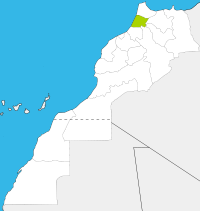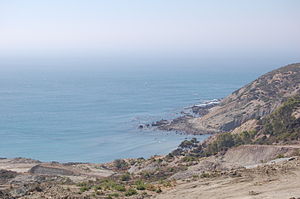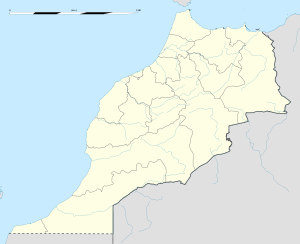- Kenitra
-
Kenitra Location in Morocco Coordinates: 34°15′N 6°35′W / 34.25°N 6.583°W Country  Morocco
MoroccoRegion Gharb-Chrarda-Béni Hssen Province Province of Kénitra Population (2004) – Total 359,142 Time zone WET (UTC+0) – Summer (DST) WEST (UTC+1) Kenitra (Moroccan Arabic name: القنيطرة, transliterated: Q'nitra, the little bridge) is a city in Morocco, formerly (1932–1956) known as Port Lyautey. It is a port on the Sebou River, has a population in 2004 of 359,142 [1] and is the capital of the Gharb-Chrarda-Béni Hssen region. During the Cold War Kenitra's U.S. Naval Air Facility served as a stopping point in North Africa
Contents
History
Before 1912
Kenitra is 6 miles (10 km) east of the Mehdiya ruins, a site of foreign occupation dating back to the Carthaginian period. In terms of some of the earliest known prehistory of this area, the Phoenicians settled the coastline along this part of Morocco as early as the first millennium BC; known back then by Thamusida. The major settlement nearest Kenitra was Chellah, somewhat to the south along the banks of the Oued Bou Regreg.[2]
Kenitra draws its name from a culvert built at Fouarat lake upstream of the kasbah. This culvert was destroyed in 1928. In 1933, the French officially named the locale "Port Lyautey". It was renamed "Kenitra" in 1956 as Morocco gained its independence.
French Protectorate
In March 1912 the French government and the Sultan of Morocco, Abd-El-Hafid, signed the Treaty of Fez. Because of his growing unpopularity, the Sultan asked the French government for protection against the Berber rebel tribes surrounding Fez. France appointed General Lyautey resident-general in Morocco.
General Lyautey restored peace and order to the country after crushing the tribal uprising. After safely moving the Sultan from Fez to the current capital city, Rabat, Lyautey began his task of civilian administration.
One of the first preoccupations of General Lyautey was to build ports along the inhabitable Atlantic coast where there were no natural harbors. After 1912 the port of Kenitra - at the mouth of the Sebou river - became the best river port in Morocco.[3]
Kenitra has grown rapidly to be a shipping centre for agricultural produce (mainly fruit), fish, timber, and lead and zinc ores. The city’s industrial area lies upstream of the port.
In a letter to president Roosevelt, Frank Knox, secretary of the navy, wrote:“For outstanding participation in the capture of Port Lyautey Airfield, French Morocco, November 10, 1942. With a U. S. Army raider detachment embarked, the DALLAS, crossing a treacherous bar against heavy surf in order to reach the mouth of the Sebou River, broke through a steel cable boom obstructing the channel, forced the course ten miles upstream under hostile fire, and successfully landed troops without material damage or loss of life. Her distinctive fulfillment of a difficult and hazardous mission contributed materially to the victorious achievement of the Northern Attack Group.”[4]
After Operation Torch, the Americans used the French facilities as a military base. Craw Field, named for Medal of Honor recipient Colonel The U.S. Navy captured the Port Lyautey fighter base from the Vichy French in November 1942, at the time of the American invasion of North Africa. The Navy ran the base without asking the French a single "S'il vous plait" until 1947, when the State Department negotiated reversion of control to France. In 1950, before Korea, under the "economy" regime of former Defense Secretary Louis Johnson, a $23,000,000 expansion was authorized, but then Korea exploded. The sixth fleet tripled. In the fifties, there were nearly 10,000 persons on the base which was the largest aggregation of Americans in any one overseas base outside Japan. Later, the base at Kenitra was expanded to become a U.S. Naval Air Station.[5] The base was shared by both the USA and Morocco through "The Cold War". A small Navy communications out-station at Sidi Yahia closed in the mid 1970s. The Air-Station was closed in 1991.
Population
Population of Kénitra province from 1982 to 2010 1982 1994 2004 2010 188,194 292,453 359,142 931,027 Areas and neighborhoods
- Médina
- Khabazate
- La Cigogne
- Modern city
- Mimosa
- Ville Haute
- Popular districts
- Saknia
- Ouled Oujih
- Maghrib al Arabi
- Residential districts
- Bir Rami
- Val fleury
Colleges and universities
- Université Ibn Tofail (UIT)
- ENCG Kénitra (École Nationale de Commerce et de Gestion de Kénitra)
- HECI Kénitra (Hautes Etudes Commerciales et Informatiques)
- ENSA Kénitra (École Nationale des Sciences Appliquées de Kénitra)
Transportation
The city is served by two railway stations: Kenitra-Ville and Kenitra-Medina. A shuttle train, TNR, connects the city, every 30 minutes, to Rabat and Casablanca.
A high-speed rail line to Tangier is planned to be completed in 2013 (see Kenitra-Tangier high-speed rail line).
Sports
Kenitra Athletic Club,KAC
In 1938, a group of Kenitra natives created KAC. This group of soccer lovers wanted to resist French domination in sports in Morocco. The team, made entirely of Kenitra natives, succeeded to reach premier Moroccan soccer league in 1956. In 1960, KAC won its first championship league of Morocco. KAC embarked in a journey of glories by winning the 1973-81-82 championship leagues and the 1961 throne cup. One name comes to mind when talking about KAC. Ahmed Souiri was a manager and coach who dedicated his life in training and inspiring young soccer players. KAC has produced many international soccer player who enriched the Moroccan soccer team. To name a few Bouliahiaoui, Khalifa were among the players who helped the national soccer team qualify to the second round of world cup finals in Mexico. Mohammed Boussati still hold a national record of goals by scoring 25 goals in one soccer championship season 1981-82.
Ajax Kenitra
The local indoor soccer club took a lead in representing Morocco in many international indoor soccer tournaments. Many tributes should be paid to Mohammed Nhaida for his role in managing the club.
Natives from Kenitra
Kenitra was the birthplace of:
- Saïd Aouita, Olympic athlete
- Amina Ait Hammou, Olympic athlete
- Youssef Chippo, International football player
See also
- Bouknadel
- Hubert Lyautey
- Battle for Port Lyautey
- Badr Hari
Notes and references
- ^ "Recensement Général De La Population Et De L'Habitat De 2004". hcp.ma. http://www.hcp.ma/pubData/Demographie/RGPH/Populationlegale(1).pdf. Retrieved 2010-01-06.
- ^ C. Michael Hogan, Chellah, The Megalithic Portal, ed. A. Burnham, 2007 [1]
- ^ "In Morocco" by Edith Wharton, New York Charles Scribener's Sons 1920
- ^ http://www.portlyautey.com/Port%20Lyautey%20History.htm
- ^ History of Port Lyautey
External links
- First site for the City of Kenitra
- Premier Portail d'information de La ville de Kenitra
- Entry in Lexicorient
- BTS Genie Informatique Lycee Technique Ibn Sina
- Association Nationale des Professeurs Agreges du Maroc - ANAPAM -
- Pictures of U.S. Naval base facilities in Kenitra
- Histoire de Kenitra / Port-Lyautey en images de 1911 au 1956
- http://mimouniouafae.webs.com/ photos de kenitra
Coordinates: 34°15′N 6°35′W / 34.25°N 6.583°W
 Gharb-Chrarda-Beni Hssen regionCapital: Kenitra
Gharb-Chrarda-Beni Hssen regionCapital: KenitraProvinces Kenitra Province · Sidi Kacem Province ·
Cities Ain Dorij · Arbaoua · Dar Gueddari · Had Kourt · Jorf El Melha · Kenitra · Khnichet · Lalla Mimouna · Mechra Bel Ksiri · Mehdya · Moulay Bousselham · Ouazzane · Sidi Allal Tazi · Sidi Kacem · Sidi Sliman · Sidi Taibi · Sidi Yahya El Gharb · Souk Larbaa · ZiraraCategories:- Populated places in Morocco
- Port cities in Morocco
- Gharb-Chrarda-Béni Hssen Region
- Médina
Wikimedia Foundation. 2010.



